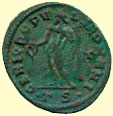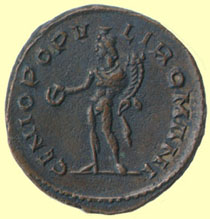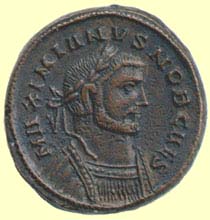Contents -
Previous Article -
Next Article
Diocletian Reforms the Money System and the Coinage
c. A.D. 301
To view a collection of bronze Follises issued by Diocletian and the tetrarchs, please see the Coin Gallery Thumbnail Pages showcasing this type or you may browse the individual Coin Gallery pages to view a larger, more detailed image of these coins individually.
 Diocletian took several steps to strengthen the economy and end the runaway inflation and economic hard times of the Third Century. By about A. D. 268, the "silver" coins were mostly copper and had only a thin silver plating if they contained any silver at all. He had his mints strike gold aurei at a weight of sixty pieces to the Roman pound. To replace the debased silver coins of the Third Century, he had the mints strike silver coins of good purity. He introduced a large bronze coin called the follis. This coin was about the size of a United States half dollar (30 mm) but thicker. This coin, as well as its half and quarter piece, served the common people as small change. With the return of good gold and silver
Diocletian took several steps to strengthen the economy and end the runaway inflation and economic hard times of the Third Century. By about A. D. 268, the "silver" coins were mostly copper and had only a thin silver plating if they contained any silver at all. He had his mints strike gold aurei at a weight of sixty pieces to the Roman pound. To replace the debased silver coins of the Third Century, he had the mints strike silver coins of good purity. He introduced a large bronze coin called the follis. This coin was about the size of a United States half dollar (30 mm) but thicker. This coin, as well as its half and quarter piece, served the common people as small change. With the return of good gold and silver  money, prices of goods and services stabilized when they were to be paid for in gold or silver. The situation with the bronze coins is another story. Since they were not made of precious metal and were much smaller than the old sestertius and its parts, they had little intrinsic value. The government had to keep passing laws to make people honor them and use then at their face value. They could not easily be converted to gold unless one went to a money changer, who would charge a huge commission if they were even willing to convert the money at all. Gold was usually reserved for the payment of the army and payments to foreign governments.
money, prices of goods and services stabilized when they were to be paid for in gold or silver. The situation with the bronze coins is another story. Since they were not made of precious metal and were much smaller than the old sestertius and its parts, they had little intrinsic value. The government had to keep passing laws to make people honor them and use then at their face value. They could not easily be converted to gold unless one went to a money changer, who would charge a huge commission if they were even willing to convert the money at all. Gold was usually reserved for the payment of the army and payments to foreign governments.
One of the main differences between ancient money and modern money is that the value of a coin in the ancient world was equal to the value of the precious metal it contained. Since copper and bronze were not precious metals, it would take a very large bronze coin to have an intrinsic value (the value of its metal content) that was high enough to be used as money. In our modern world, a slip of paper is worth twenty dollars because the government says it is worth twenty dollars and has printed a design on  it identifying it as a twenty dollar bill. Less than one hundred fifty years ago, most people would readily accept the twenty dollar gold coin but would laugh if you offered the twenty dollar bill, calling it by such derisive names as "shinplaster" or "funny money." So it was with the bronze coins of the Roman empire. People in ancient times were not used to the idea that a piece of metal with no intrinsic value should be worth something just because the government says so, especially if the government is known to play games and cheat on the value of its bronze money. When the government was stable with a good emperor on the throne and the economy was good, you could exchange your bronze for the equivalent face value of silver at a money changer’s booth and only pay a few percent conversion fee. Can you imagine having to pay the bank a nickel or ten cents just to take your one hundred pennies and give you four quarters? This is the way it was in the Roman world. To make matters worse, many times the Roman government would not accept its own bronze coins as payment for taxes. They required taxes to be paid in good gold or silver, and would pay tradesmen and merchants who
it identifying it as a twenty dollar bill. Less than one hundred fifty years ago, most people would readily accept the twenty dollar gold coin but would laugh if you offered the twenty dollar bill, calling it by such derisive names as "shinplaster" or "funny money." So it was with the bronze coins of the Roman empire. People in ancient times were not used to the idea that a piece of metal with no intrinsic value should be worth something just because the government says so, especially if the government is known to play games and cheat on the value of its bronze money. When the government was stable with a good emperor on the throne and the economy was good, you could exchange your bronze for the equivalent face value of silver at a money changer’s booth and only pay a few percent conversion fee. Can you imagine having to pay the bank a nickel or ten cents just to take your one hundred pennies and give you four quarters? This is the way it was in the Roman world. To make matters worse, many times the Roman government would not accept its own bronze coins as payment for taxes. They required taxes to be paid in good gold or silver, and would pay tradesmen and merchants who  supplied the army or government with goods and services in small bronze coins. No wonder the harness maker, the grain miller, the boot maker, the bladesmith, the farmer, and the ship owner wanted gold and despised the bronze pieces. Not only were taxes very oppressive in the late Roman world, but the citizens were forced to endure two standards of money. As a result, the bronze follis kept getting smaller and smaller between the years of A. D. 300 and 348 as inflation kept causing the value of the bronze to drop. The follis started out as a coin 28 - 30 mm in diameter and, by 348, was a thin little shadow of its former self about 16 - 17 mm in diameter.
supplied the army or government with goods and services in small bronze coins. No wonder the harness maker, the grain miller, the boot maker, the bladesmith, the farmer, and the ship owner wanted gold and despised the bronze pieces. Not only were taxes very oppressive in the late Roman world, but the citizens were forced to endure two standards of money. As a result, the bronze follis kept getting smaller and smaller between the years of A. D. 300 and 348 as inflation kept causing the value of the bronze to drop. The follis started out as a coin 28 - 30 mm in diameter and, by 348, was a thin little shadow of its former self about 16 - 17 mm in diameter.
The four coins displayed on this page illustrate the changes brought to the coinage in A.D. 295 - 296 by Diocletian's reforms. The top two images are obverse and reverse of the older antoniniani or radiates which are the same denomination introduced by Caracalla early in the Third Century. Caracalla's coin was about fifty percent silver, but by the time of Diocletian the silver content was just two to five percent with a thin plating of silver on the surface. The larger coins toward the bottom of the page are the new bronze denominations introduced after A.D. 396, which were also plated with silver. As in the case of the radiates, the silver soon wore off leaving gray - brown billon underneath. We do not know what name the Romans had for either the old denomination or this new one, but coin collectors and scholars call this coin a follis today. The few surviving ancient written works refer to a nomisma, which roughly translates as "unit of money."
The bright silver plating is gone from both of these coins, though a few traces remain on the radiate. Though they had no knowledge of electricity, the Roman mint workers discovered a clever way of plating these coins. Nice, bright specimens of both types are easy to find at ancient coin dealers' shops, with the radiates priced at around thirty dollars and the follises bringing between fifty and seventy dollars for the more common reverses and mints. The author has quite a collection of radiates in superb condition struck during the reign of Probus.
Go to next article:
Go back to previous article:
Return to Late Roman Empire Table of Contents
Go to Collecting Roman Coins Table of Contents
 Diocletian took several steps to strengthen the economy and end the runaway inflation and economic hard times of the Third Century. By about A. D. 268, the "silver" coins were mostly copper and had only a thin silver plating if they contained any silver at all. He had his mints strike gold aurei at a weight of sixty pieces to the Roman pound. To replace the debased silver coins of the Third Century, he had the mints strike silver coins of good purity. He introduced a large bronze coin called the follis. This coin was about the size of a United States half dollar (30 mm) but thicker. This coin, as well as its half and quarter piece, served the common people as small change. With the return of good gold and silver
Diocletian took several steps to strengthen the economy and end the runaway inflation and economic hard times of the Third Century. By about A. D. 268, the "silver" coins were mostly copper and had only a thin silver plating if they contained any silver at all. He had his mints strike gold aurei at a weight of sixty pieces to the Roman pound. To replace the debased silver coins of the Third Century, he had the mints strike silver coins of good purity. He introduced a large bronze coin called the follis. This coin was about the size of a United States half dollar (30 mm) but thicker. This coin, as well as its half and quarter piece, served the common people as small change. With the return of good gold and silver  money, prices of goods and services stabilized when they were to be paid for in gold or silver. The situation with the bronze coins is another story. Since they were not made of precious metal and were much smaller than the old sestertius and its parts, they had little intrinsic value. The government had to keep passing laws to make people honor them and use then at their face value. They could not easily be converted to gold unless one went to a money changer, who would charge a huge commission if they were even willing to convert the money at all. Gold was usually reserved for the payment of the army and payments to foreign governments.
money, prices of goods and services stabilized when they were to be paid for in gold or silver. The situation with the bronze coins is another story. Since they were not made of precious metal and were much smaller than the old sestertius and its parts, they had little intrinsic value. The government had to keep passing laws to make people honor them and use then at their face value. They could not easily be converted to gold unless one went to a money changer, who would charge a huge commission if they were even willing to convert the money at all. Gold was usually reserved for the payment of the army and payments to foreign governments.
 it identifying it as a twenty dollar bill. Less than one hundred fifty years ago, most people would readily accept the twenty dollar gold coin but would laugh if you offered the twenty dollar bill, calling it by such derisive names as "shinplaster" or "funny money." So it was with the bronze coins of the Roman empire. People in ancient times were not used to the idea that a piece of metal with no intrinsic value should be worth something just because the government says so, especially if the government is known to play games and cheat on the value of its bronze money. When the government was stable with a good emperor on the throne and the economy was good, you could exchange your bronze for the equivalent face value of silver at a money changer’s booth and only pay a few percent conversion fee. Can you imagine having to pay the bank a nickel or ten cents just to take your one hundred pennies and give you four quarters? This is the way it was in the Roman world. To make matters worse, many times the Roman government would not accept its own bronze coins as payment for taxes. They required taxes to be paid in good gold or silver, and would pay tradesmen and merchants who
it identifying it as a twenty dollar bill. Less than one hundred fifty years ago, most people would readily accept the twenty dollar gold coin but would laugh if you offered the twenty dollar bill, calling it by such derisive names as "shinplaster" or "funny money." So it was with the bronze coins of the Roman empire. People in ancient times were not used to the idea that a piece of metal with no intrinsic value should be worth something just because the government says so, especially if the government is known to play games and cheat on the value of its bronze money. When the government was stable with a good emperor on the throne and the economy was good, you could exchange your bronze for the equivalent face value of silver at a money changer’s booth and only pay a few percent conversion fee. Can you imagine having to pay the bank a nickel or ten cents just to take your one hundred pennies and give you four quarters? This is the way it was in the Roman world. To make matters worse, many times the Roman government would not accept its own bronze coins as payment for taxes. They required taxes to be paid in good gold or silver, and would pay tradesmen and merchants who  supplied the army or government with goods and services in small bronze coins. No wonder the harness maker, the grain miller, the boot maker, the bladesmith, the farmer, and the ship owner wanted gold and despised the bronze pieces. Not only were taxes very oppressive in the late Roman world, but the citizens were forced to endure two standards of money. As a result, the bronze follis kept getting smaller and smaller between the years of A. D. 300 and 348 as inflation kept causing the value of the bronze to drop. The follis started out as a coin 28 - 30 mm in diameter and, by 348, was a thin little shadow of its former self about 16 - 17 mm in diameter.
supplied the army or government with goods and services in small bronze coins. No wonder the harness maker, the grain miller, the boot maker, the bladesmith, the farmer, and the ship owner wanted gold and despised the bronze pieces. Not only were taxes very oppressive in the late Roman world, but the citizens were forced to endure two standards of money. As a result, the bronze follis kept getting smaller and smaller between the years of A. D. 300 and 348 as inflation kept causing the value of the bronze to drop. The follis started out as a coin 28 - 30 mm in diameter and, by 348, was a thin little shadow of its former self about 16 - 17 mm in diameter.